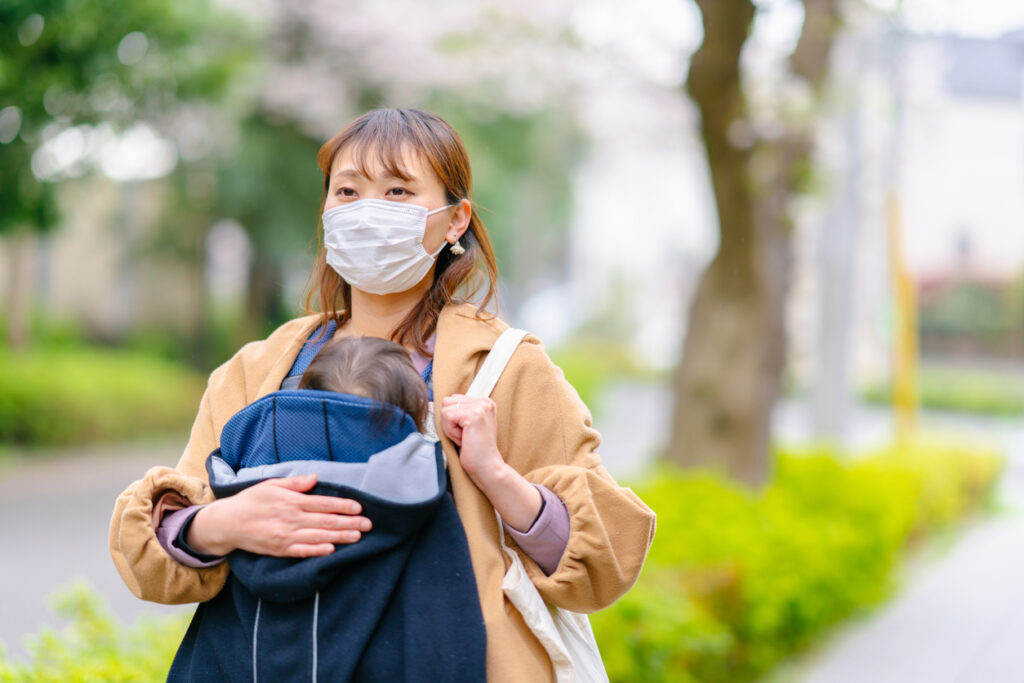The History and Benefits of Baby Wearing in Japan
Keeping Baby Close and Cozy
Whether you’re on the go with your little one or staying closer to home, consider wearing your baby—a comfortable, convenient and longstanding choice for parents in Japanese cities.
Before I had kids, something that struck me about my yearly trips to Japan was how visible young children are. Of course, I knew that Japan is considered a super-aging society, with one in three people in the elderly category. But, compared to everywhere I lived and visited in North America, I saw so many more babies out and about when I was in Japan.
Part of this is potentially related to the enduring nature of sansaiji shinwa (the myth of the first three years.) Sansaiji shinwa is the belief that a mother must fully dedicate herself to child-rearing for the first three years of her baby’s life or risk averse outcomes. Part of this is also the so-called taiki jidou mondai, or waitlisted children problem, whereby Japan has a shortage of childcare resources—especially for women working full time. Yet, the high visibility of babies in contemporary Japan is also due to the fact that they are largely being carried through public spaces. You’ll see their tiny heads popping out of front and back carriers, as their caregivers go about their days.
No Stroller, No Problem
 © Photo by iStock: recep-bg
© Photo by iStock: recep-bgAt the time, I felt inspired. Baby wearing solved one of my dilemmas about having children in the first place. I always had trouble envisioning myself handling a stroller through the city streets, folding it to get on a bus or in a cafe or fighting through the snow (hi Canada!). However, with my baby strapped to me, I could better imagine what my life would look like. When my first and second daughters came, carriers were indispensable to me whether I was in North America or Japan.
With my girls in soft carriers or more structured ones as they grew, I was able to navigate the cityscape more seamlessly. I could attend to their needs for closeness, milk, stimulation and sleep while still doing what I needed. Indeed, even preschool pickup and park time these days are facilitated by the carrier. My younger daughter can snuggle up or interact with inquisitive kids on the playground depending on her mood. Meanwhile, my eldest daughter’s outdoor play is less restricted by the baby’s needs.
The History Of Baby Wearing in Japan
 © Photo by Public Domain – Wikicommons
© Photo by Public Domain – WikicommonsSo, why are carriers so popular here? In fact, their ubiquity has much to do with Japan’s long history of baby-wearing. Traditionally, Japanese mothers, as well as elder children or other carriers, wore their babies on their backs. This is known as onbu in Japanese. In fact, drawings from the later Heian period (794-1185) show women placing their babies inside the obi (kimono sash). By the Edo period (1603-1867), there are depictions of older children caring for their younger siblings in this way, as well.
In 1953, in the postwar period, the first company specialized in making obi for the explicit purpose of carrying babies was established, allowing the mother to have her hands free to work. Which also helped baby see the world through her eyes. This practice remains popular in Japan, in onbu himo, or back-carry baby carriers.
In 1975, the new term mae onbu (literally: front back carry) came into usage. This was around the same time as imports of front-wearing baby slings from the United States entered Japan. Since then, dakko himo (front baby carriers) have dominated the market due to their ability to ease breastfeeding on the go and keep a close eye on baby. Even though the front carriers are largely imported from the United States or Western Europe, Japan’s long history of baby-wearing means that carrying babies remains second nature and exceptionally popular, particularly in baby’s first year.
Baby Wearing Benefits
 © Photo by iStock: monzenmachi
© Photo by iStock: monzenmachiWhat are some benefits of baby wearing in contemporary Japan? In my experience, it has been an invaluable aid in raising young children here in several ways:
- Ease of navigating public transportation, from stations without escalators and elevators to packed trains.
- Flexibility in places to shop and eat out; you don’t need to worry about whether the stroller will fit through the door or if the baby will wake up when you take them out of it.
- Ability to meet baby’s needs for closeness and breastfeeding, and still get on with your day.
- Ability to exercise and get outside in the earlier postpartum period since you can breastfeed on the move.
- Ability to get housework done and keep baby happy simultaneously/
How To ‘Baby Wear’
 © Photo by iStock: recep-bg
© Photo by iStock: recep-bgThere are several different types of carriers to choose from if you are considering baby-wearing. As you explore the baby carriers on the market, remember to consider your baby’s age and temperament. How old is your baby? They cannot be front-facing before five months or when they have strong neck support. Being close to a caregiver’s skin also helps newborns regulate their breathing and body temperature. So, for the early days, some recommend soft carriers rather than structured ones.
Soft Carriers
- Betta CarryMe: worn crossbody
- Baby wraps: like Boba or Solly made of stretchy material that you wrap around your body to hold baby
Soft-Structured Carriers
- Ergobaby’s Embrace: combines stretch, softness and support
Soft-structured carriers can also help soothe colicky babies for the first few months or fourth trimester as they are getting used to life outside the womb.
Structured Carriers (For Slightly Older Children)
Structured carriers provide proper hip support and comfort for baby while reducing the strain on your back and shoulders. They can be used from birth right up until approximately 36 months. They also offer a variety of baby-wearing positions. These include front carry (facing parent or facing out), hip carry and back carry. Having a structured carrier is great with a toddler, as well.
With a baby carrier on hand, outings don’t have to end with one parent shuttling a sleeping toddler in arms! My eldest daughter napped happily in her carrier until she dropped her daytime sleep at two and a half.
Baby wearing in Japan today combines a long domestic history of slinging a baby to your back with the global bestsellers first introduced to the Japanese market over four decades ago. Why not try this fusion of Japanese and foreign childrearing? Snuggle your little one against you in a baby carrier next time you’re out!
Both newbies and seasoned vets can enjoy the freedom of movement and ability to soothe that come with baby wearing at home and on the go in Japan!
This articled has been republished for 2024.
















Leave a Reply